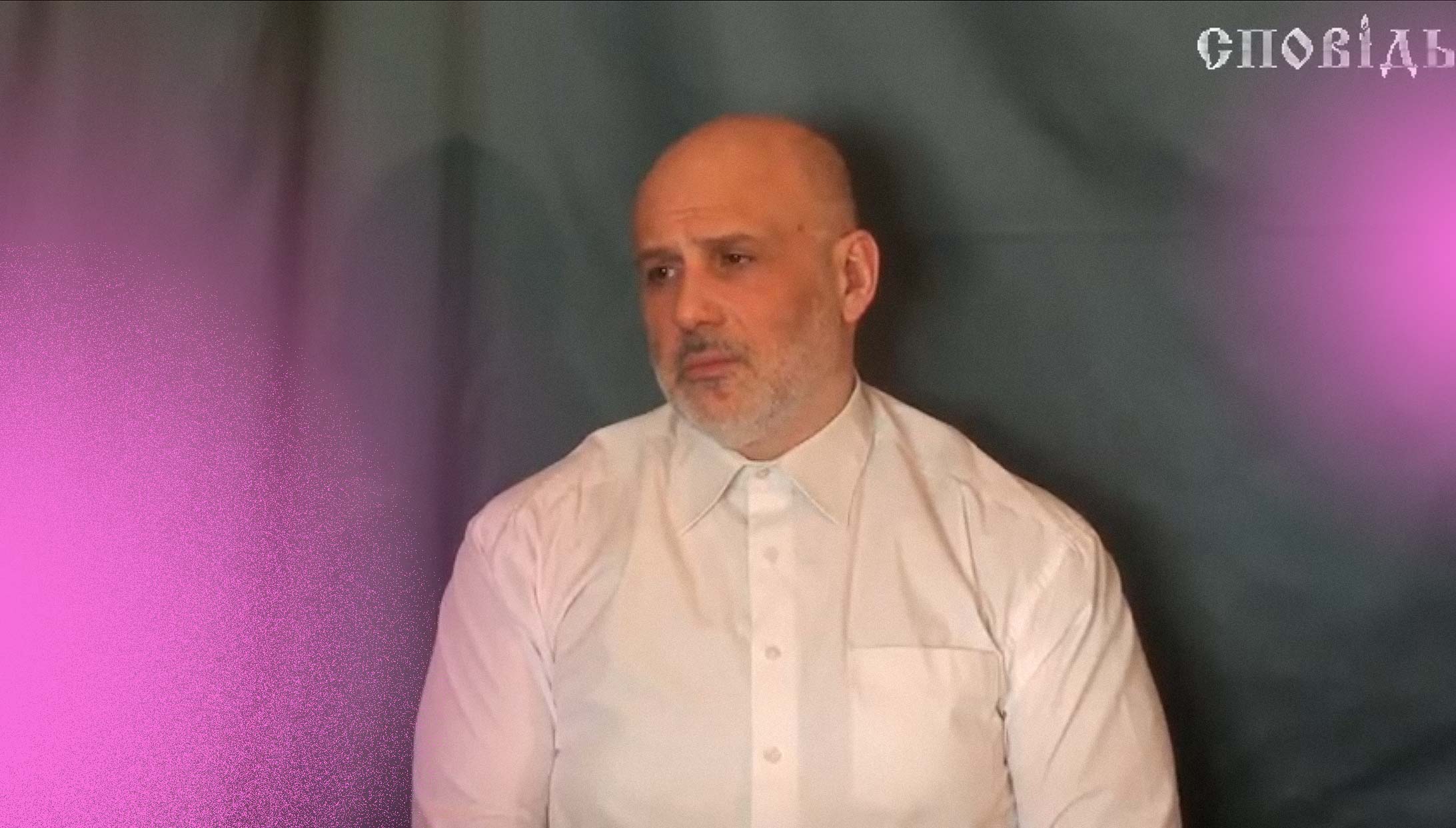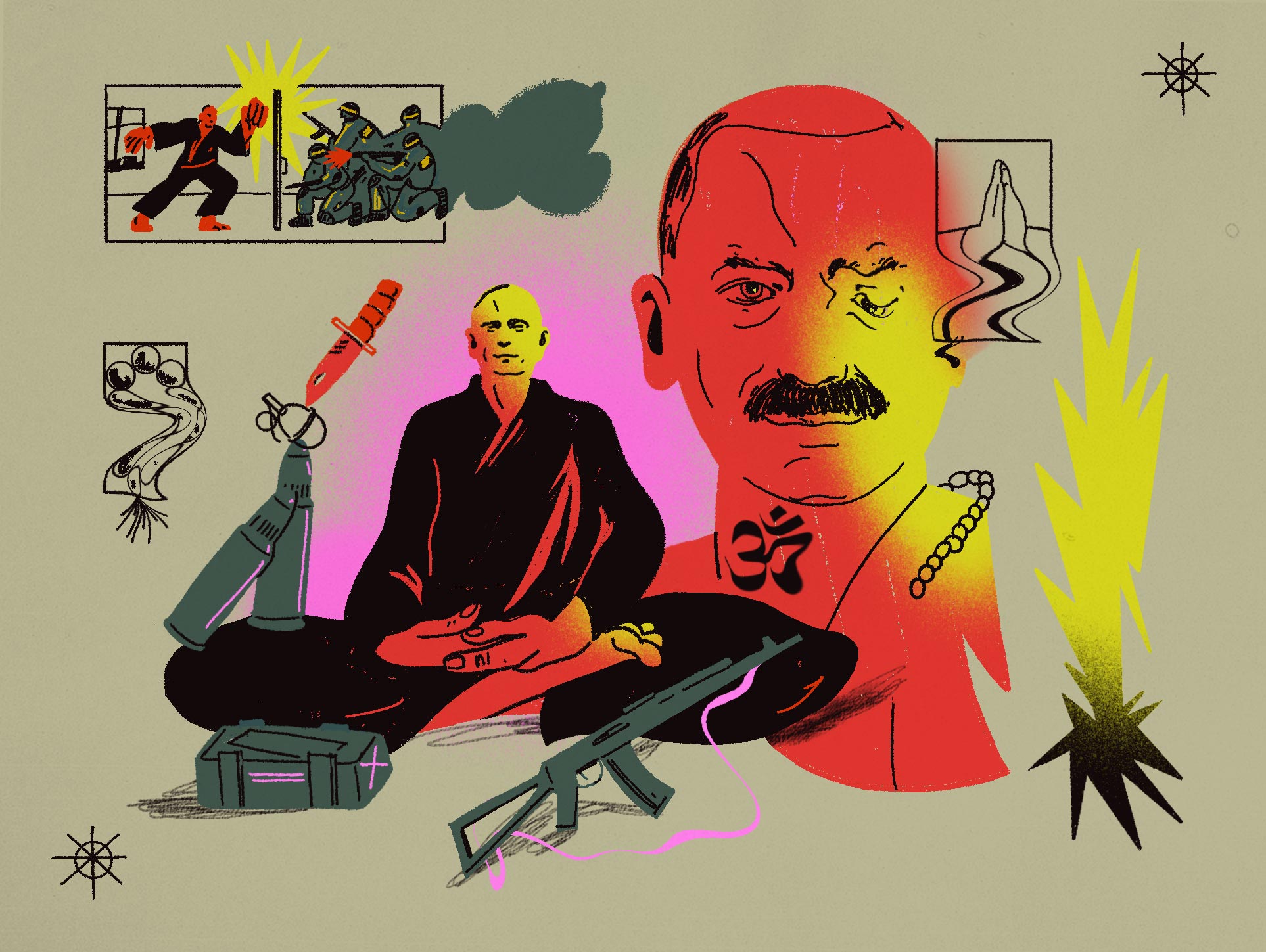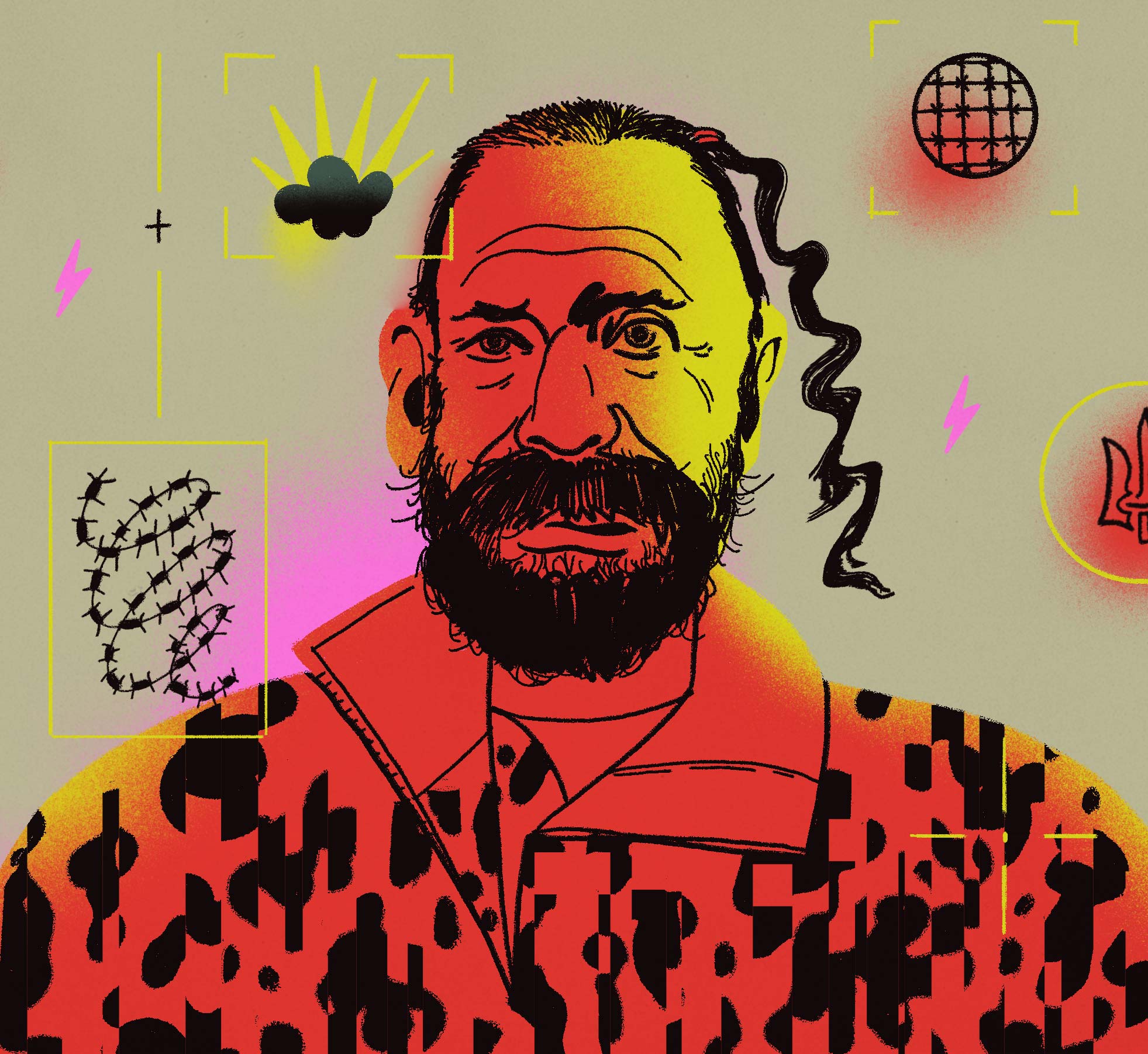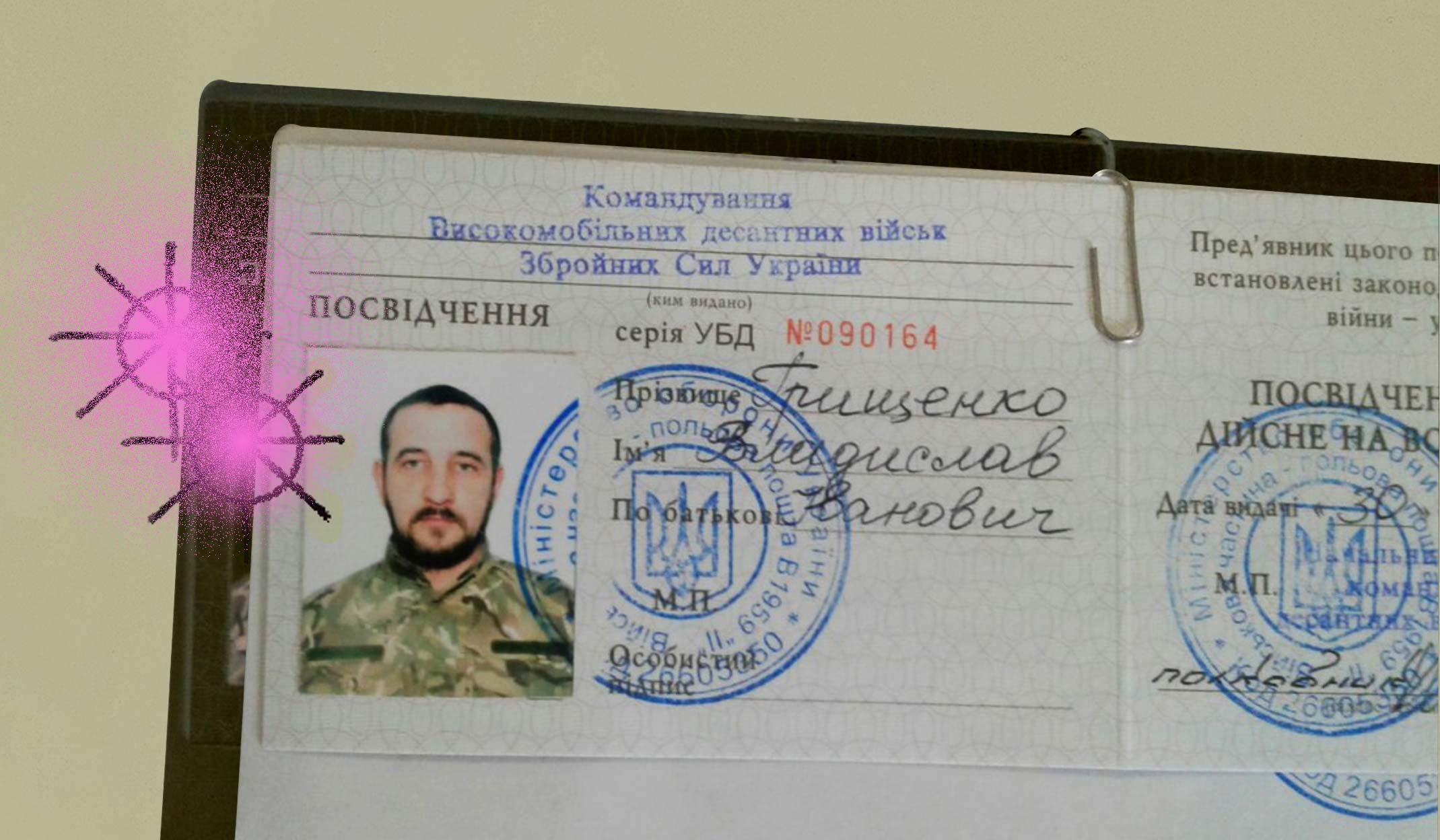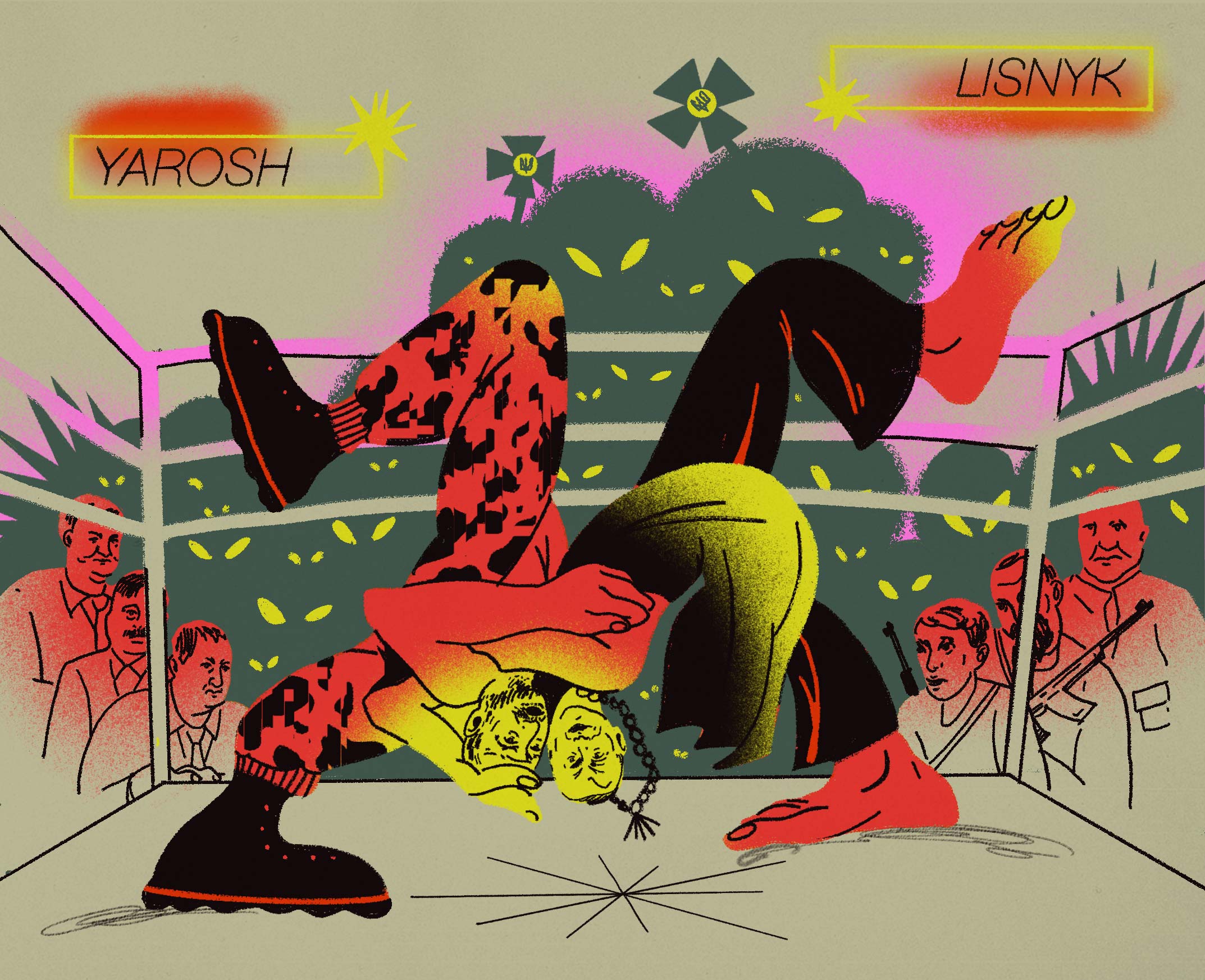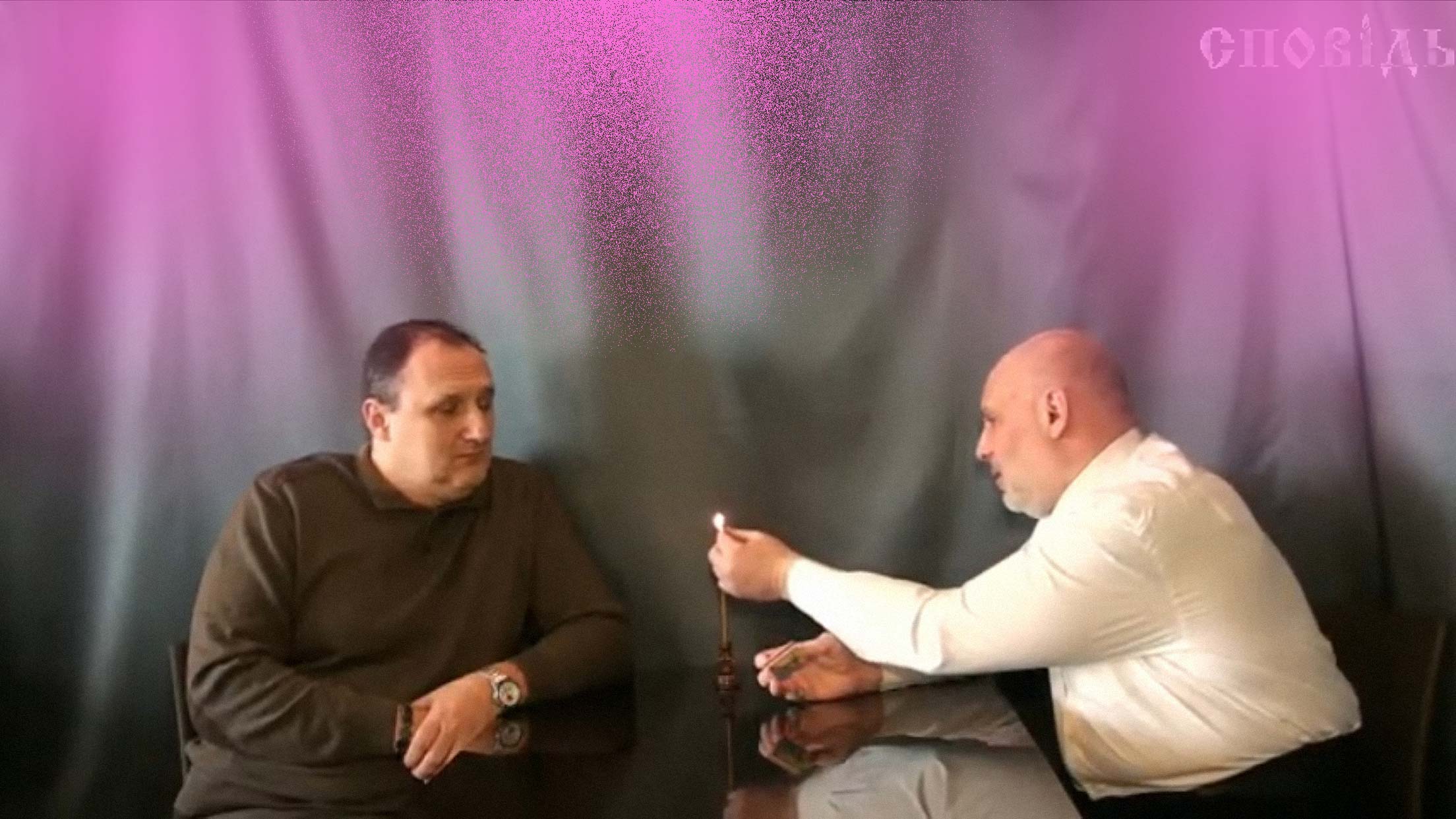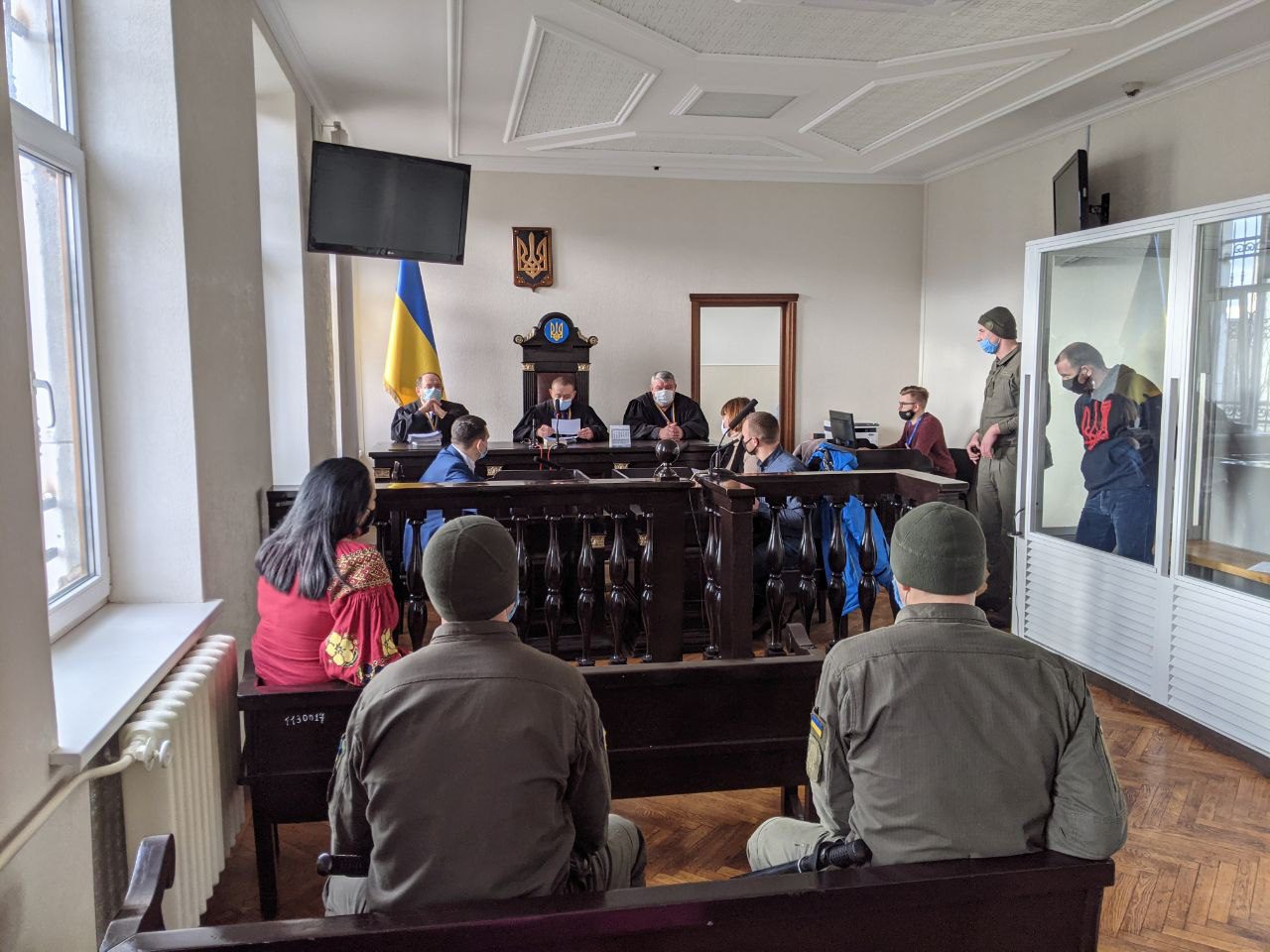The facts that the Gryshchenko spouses were closely acquainted with some of the security forces forced us to study in more detail the connections between representatives of the security agencies and volunteer battalions. During the investigation, we managed to find several interesting facts about such cooperation at once, which we will tell about in this part of the material.
These stories are not directly related to the murder of Pavel Sheremet but are important for a general understanding of how the security forces and some representatives of the volunteer battalions cooperate with each other.
Veterans and fiscals
None of the known facts of the Gryshchenko spouses’ biographies indicate their connection with anyone in Russia, where the former employer of Pavel Sheremet, the former Minister of Revenue and Duties Oleksandr Klymenko, is hiding from the Ukrainian justice system. Nor are there any ties to Belarus, the leadership of which had long-standing scores with Sheremet and, according to recently released audio recordings, may even have planned his assassination in 2012.
However, there is a very short chain linking these and other controversial and willing characters with the special services and the country’s top political elite, which came to power after the 2014 revolution. The story of a lobbying organization helps to understand it.
In December 2019, shortly after “Puma”’s name became known throughout the country, Inna Gryshchenko headed the veteran organization “Association of Combatants of Ukraine”. Almost all people involved in it are to one degree or another connected with the DUK (Volunteer Ukrainian Corps) Right Sector.
Before “Puma”, the association was headed by Vitaliy Prymenko, a veteran of the nationalist movement of Ukraine, callsign “Kotyara”, who had been repeatedly convicted, including for blowing up a car. Primenko and his inner circle believe that Inna Gryshchenko “squeezed” their association, acting in concert with one of the founders: entrepreneur Oleg Volodarsky. This is confirmed by Prymenko’s friend Maksym Butko, an activist of the Right Sector party, whose organization was one of the founders of the “Association of Combatants”.
Inna Gryshchenko herself rejects any accusations about “squeezing” the Association and refuses to address these accusations.
“Why should I defend myself against people whom I consider to be, at the very least, morons? These people are not interesting to me at all,” she said in an interview with Zaborona. However, she confirmed that she was invited to the post as head of the association by two other founders – Kryvyi Rih youth activist Serhiy Andriychuk and Oleg Volodarsky.
Volodarsky likes to call himself a “human rights activist” and shoots his own TV program, where he is an interviewer. In this role, he made an interview with Vladyslav Gryshchenko, full of interesting information.

Screenshot from Oleg Volodarsky’s program “Confession”
Before “Puma” took over the leadership of the organization, members of the Association held two press conferences, one of which was dedicated to a specialized topic: the status of fighters of volunteer battalions. The other topic was somewhat unexpected. Its members lobbied for the creation of the state bureau of financial investigation, a new Ukrainian special service that would take away from other law enforcement agencies their gold mine: the functions of investigating economic crimes. As the story of the star in the first part of our investigation of the Sheremet case, ex-minister Oleksandr Klymenko, shows, this area brings hundreds of millions of dollars to corrupt officials.
Volodarsky was the host of the conference. At a distance from him sat, in the role of a “wedding combatant”, the leader of the far-right organization “White Hammer” and one of the founders of the Right Sector Vladyslav Goranin, who was suspected of murdering three traffic police officers in March 2014.
The tone at the event was set by Andriy Dubovyk, the former deputy commander of the Alpha SBU special forces, with an interesting call sign for a person from his environment: “Pravosek”. A career intelligence officer, Dubovyk was one of Arseniy Yatsenyuk’s bodyguards during the revolution. “The leaders of the country knew me from Maidan,” he said in one of his interview. At the time of the press conference, he was the head of the security service of the National Bank of Ukraine, as he himself confirmed in an interview with Zaborona.

Finally, the most eminent participant was Vadim Melnyk, the former head of the main investigation department of the fiscal service. The Bureau of Financial Investigation was a personal project of his. Looking ahead, it is worth saying that the law on the creation of the bureau is still stalled in the Rada, but Melnyk has achieved more: since December 2020, he has been the head of the fiscal service of Ukraine.
So, all that separates the “suspect” “Puma” in the murder of Pavel Sheremet from top-level officials Melnyk and Yatsenyuk are the veterans of the special services Dubovyk and Oleg Volodarsky.
In a conversation with Zaborona, Inna Gryshchenko said that she “cannot remember” who Dubovyk and Prymenko are. Dubovyk, in turn, claims that he knows the Gryshchenko spouses “only by sight”. And Vitaly Prymenko says that he knows both of them well.
Dubovyk avoided the question of his participation in lobbying for the creation of a fiscal special service with the help of veterans of the Right Sector.
“I have no interest in this association. It’s not interesting for me to get dirty in someone else’s shit,” he said to Zaborona.
It is difficult to believe in the sincerity of “Puma” and Dubovyk in this matter, for they both played too significant a role in the DUK Right Sector and are too closely connected to one legendary figure who became a victim of a political murder six months before the death of Pavel Sheremet.
War for inheritance
In December 2015, during the “Alpha” SBU special operation in an apartment in the Obolonsky district of Kyiv, the intelligence commander of the DUK Right Sector Oleg Muzhchil, call sign “Lesnik”, was killed. The sylovyky (politicians whose careers started in security services) accused him of working for the Russian special services.
Artem Dubovyk, who was then deputy commander of the anti-terrorist special forces “Alpha”, claims that he was not informed of the operation. The SBU leadership had a good reason not to inform him of their plans: Dubovyk had been a close friend of “Lesnik” since pre-war times. Shortly after the death of his friend, Dubovyk resigned from the SBU.
Oleg Muzhchill was a legendary character and had two different hypostases. Since the 1990s, he has raised up the nationalist movement in eastern Ukraine, together with two associates of the Trident organization (which later became the basis of the Right Sector) Dmytro Yarosh and Vitaly Prymenko (who in 2019 had Inna Gryshchenko “squeeze out” the association of combatants).
On the other hand, Muzhchil was a prominent figure in Ukrainian Buddhism and created a Buddhist monastery near Donetsk, which, with the outbreak of the Russian-Ukrainian war, became the base of the Right Sector. In addition to teaching the spiritual practices of Buddhism, he conducted training in martial arts and knife fighting there, the technique of which he was highly skilled in. Dubovyk, a special forces soldier, began to come to these classes a couple of years before the war. So he made friends with “Lesnik”, whom he still considers a hero of Ukraine, and not a traitor or an enemy agent.
Inna Gryshchenko and Oleg Volodarsky share the same opinion.
“He was one of the best professionals I have ever met in my life,” said “Puma” to Zaborona, while flatly refusing to comment on the “Lesnik” case. And Volodarsky tirelessly praises “Lesnik” in public speeches and on social networks.
Meanwhile, the closest associates of “Lesnik” fiercely hate “Puma” and Volodarsky. The reason for this is their controversial role in the “Lesnik” case.

Illustration: Yehor Hryb / Zaborona
“Teacher”’s heritage
The history of this conflict begins in London, where shortly before the death of “Lesnik” at the end of 2015, British supporters of Euromaidan organized the transfer of a consignment of military equipment to Ukraine. It was intended for a combat pair of saboteurs who carried out operations against pro-Russian forces in the occupied territory of Donbas. The addressees went by the callsigns “Hilda” and “Ragnar”, referring to Scandinavian mythology.
They were Olga Shevelyova and Pavel Pyatakov, Russians who, for ideological reasons, came to Ukraine to fight against their country’s army. They served in the DUK Right Sector and were direct subordinates of the chief of intelligence Oleg Muzhchil – “Lesnik” – and considered him their spiritual teacher.
Both of them were arrested on the day of the death of “Lesnik”, at the same time as the Kukels, in whose Kyiv apartment Muzhchil was shot. These four make up the backbone of the so-called “Lesnik group” and, judging by the posts in social networks, are friends with Vitaly Prymenko and his closest associate Maksym Butko.
The once high-profile “Lesnik case” is moving sluggishly to this day, but all of the defendants were released without any preventive measures back in 2016. They reject accusations of working for Russian intelligence and, on the contrary, claim that they were, together with “Lesnik”, official employees of the Main Intelligence Directorate of Ukraine.
After Olga Sheveleva (Zaborona managed to communicate with her via Messenger) went free, she learned about the package from London. The items were handed over to her, but since she had nowhere to live, she handed them over for safekeeping to her acquaintance Serhiy Andreychuk, an activist from Kryvyi Rih who later helped Inna Gryshchenko to become the head of the Combatants Association.
When housing was found, Sheveleva returned for her things, but they were gone. After a little investigation, she found out that Inna and Vlad Gryshchenko were involved in the disappearance. They claim that they simply transferred them to the front in the Georgian battalion. This became the starting point of the protracted conflict between the spouses of Hryshchenko and the associates of “Lesnik”.
Before that, both Volodarsky and Inna Gryshchenko took an active part in the fate of the members of the “group”. But as the case developed, the defendants, in their own words, began to have doubts – were the spouses Gryshchenko and Volodarsky working against them on the side of the SBU?
The realization came in the course of getting to know the case. According to the members of the group, it turned out that the key evidence against “Lesnik” and his associates was given by the same activist Serhiy Andreychuk. Zaborona contacted Andreychuk: he promised to comment but eventually stopped communicating.
The suspects in the “Lesnik” case refused to help Volodarsky and Gryshchenko. Their main complaint against the Hryshchenko family, which both Sheveleva and Valeriy Kukel, in whose apartment “Lesnik” was shot, voiced to Zaborona, was that they work for the SBU. Kukel uses the word “bum” for this (in prison jargon, it means that a person cooperates with the administration of the correctional institution).
The “Lesnik” case and the background of people associated with it illustrate how the Security Service of Ukraine continues its long tradition of cooperation with radical nationalists and semi-criminal characters. The essence of such cooperation is in attracting people who are ready for radical actions in special operations, which then allows them to shift the responsibility on them and distance themselves from dubious situations. To understand this better, you need to take an excursion into the formative years of the main Ukrainian special service.
Cover operation “Stepan Bandera”
Vitaly Prymenko smiles like the Cheshire cat. He has a thick curly beard and wears an expressive Cossack forelock. Like Vlad Gryshchenko, he was imprisoned several times, including for an attempt to blow up a car.
Of all the characters in our story, he knew “Lesnik” longer than anyone else. In 1994, both joined the paramilitary organization “Tryzub” (“Trident”), named after Stepan Bandera, and were engaged in the dissemination of its ideas in eastern Ukraine.

Illustration: Yehor Hryb / Zaborona
As part of the military structure of Trident, Prymenko held the rank of “major” and directed the activities of the organization in the Donetsk and Luhansk regions. From his story it follows that the “Lesnik” was below him in the hierarchy, being engaged in the Donetsk direction. At the same time, both were listed as Trident centurions. The senior in rank was “Colonel” Dmytro Yarosh, based in the Dnieper.
Since its inception, “Tryzub” activities have been closely linked with the Security Service of Ukraine and specifically with its future head Valentyn Nalyvaichenko. Having just graduated from the Moscow Institute of the Andropov Foreign Intelligence Service, the young Ukrainian diplomat Nalyvaichenko appeared from the beginning of the 90s at the military training camp of “Tryzub”, where he became friends with Yarosh. Zaborona talked about this with Prymenko.
In his opinion, cooperation with Nalyvaichenko was “useful” at that time. He and other members of “Tryzub” handed over “information on enemies, on Russian agents, on all kinds of anti-state actions” to Nalyvaichenko. In addition, Prymenko says, the members of the “Tryzub” carried out “cover operations”, a term that well describes the meaning of the SBU’s relations with radicals and criminals from then until now.
Nevertheless, Prymenko believes that Yarosh, in his cooperation with the SBU, went too far, and did so long before Maidan. The Trident veteran awards the former leader with the same epithet as the Hryshchenko spouses: “bum”. It is Yarosh’s cooperation with the SBU that Prymenko considers the reason for the misfortunes that fell on his lot later.
The fact is that at the end of the 2000s, Yarosh introduced Prymenko to the businessman and politician Eduard Krech, the owner of a soda factory in Sloviansk. On September 26, 2011, Prymenko met with him again, and on the same day, an explosion occurred near the car of the businessman’s former wife, Vira Krech. The driver accidentally noticed a wallet with wires under the car and threw it out on the lawn, so no one was hurt. Prymenko was arrested as the organizer of the explosion and received 6.5 years in prison under a terrorist article.
This was not his first arrest. Prymenko had previously suspected that Yarosh was setting him up, but now he was absolutely sure of this.
“The cops received information about my involvement and where I was from Yarosh,” says Prymenko. Yarosh, like Nalyvaichenko, did not respond to Zaborona’s requests for comment.
After the victory of Maidan, Prymenko was included in the list of political prisoners who were released from prisons by order of the acting President Oleksandr Turchinov. In the conditions of the rapidly approaching war with Russia, he decided not to enter into conflict with Yarosh again and instead joined the ranks of the DUK Right Sector.
“There was some hope that the damn schmuck would somehow correct himself and atone for his sins by active struggle,” says Prymenko.
Thus, a veteran of Tryzub and hereditary Cossack Prymenko ended up at the DUK base. In the opposite room lived the previously mentioned sabotage “battle pair” of “Lesnik”, the Russians Olga Shevelyova and Pavel Pyatakov. The Gryshchenko spouses, who had joined the Right Sector, were right there in the neighborhood, and Andriy Dubovyk, the deputy commander of Alpha, acted as the curator from the special services.
“Well, this is… murder, robbery.”
The story of DUK Right Sector and a number of other good-natured people is somewhat reminiscent of the plot of Quentin Tarantino’s film “Inglorious Basterds”. Many came there to wash away their criminal past with blood and showed undeniable heroism on the battlefield. At the same time, as in the old “Tryzub” times, this desperate contingent was the ideal “material” for cover operations. They were not formally attached to the SBU, but at the same time they had to die in battle or, if necessary, serve time, “for themselves and for that guy”.
In April 2014, four days after the announcement of the start of the anti-terrorist operation in Donbas, acting President of Ukraine Oleksandr Turchynov signed a law on large-scale amnesty. The author of the law was SBU deputy and general Andriy Kozhemyakin, one of the leaders of the Batkivshchyna party, who played an important role in the leadership of Maidan. Opponents of Maidan claimed that Dubovuk was his assistant, but in an interview with Zaborona, he denied this connection.
In an interview with the BBC in 2017, Turchynov recalled a meeting with one of the volunteer battalions at the beginning of the war: “One of those present, all in tattoos, asked: ‘Will there be amnesty or not? Some of our guys want to know.’ I ask, what kind of guys? ‘Well, there’s … murder, robbery’.”
Vladyslav Gryshchenko quite accurately fits the description of such “guys”, moreover, those of them who are not alien to close cooperation with the security forces. In December 2013, he was released from the Buchansky penal colony and immediately ended up on Maidan. “After all his prison sentences, his story began with me and with Maidan,” says Inna Gryshchenko.
To get free ahead of schedule “Bucha”, according to his wife, with his “golden hands”, helped as a cabinetmaker. With these golden hands, the room for long visits was repaired. The room was headed by “Puma”, who worked in the penal colony as a psychologist.
Inna Gryshchenko says that the “contingent” of the Bucha colony enthusiastically embraced the revolution. She bought sandwiches with the money collected by prisoners and, often without taking off her uniform, brought them to Maidan. She refuses to say in which centurion her future husband was and whom she joined on Maidan, but claims that she knows a lot about the origin of the Right Sector – although she does not intend to share this knowledge.
Fifth battalion
When the war began, Vlad Gryshchenko first tried to mobilize through the military registration and enlistment office, but when this did not work, he called the Right Sector hotline and was accepted into the ranks of the DUK without any problems. He told about this in an interview with Volodarsky.
His future wife Inna first came to the base as a volunteer, and then the commander of the DUK, Andriy Stempitsky, invited her to become a full-time psychologist – that is, according to her husband in the same interview, to do the same thing that she did at her previous place of work.
Puma herself said in an interview with Zaborona that “she was the person who created the counterintelligence service in Right Sector”. This is confirmed by some of our sources in the 5th battalion.
Vlad Gryshchenko quickly became the commander of a reconnaissance group in the same battalion. A video published in the spring of 2015 with the participation of Vlad Gryshchenko designates his reconnaissance group as “Terminator Special Forces”. None of the Right Sector fighters we interviewed had heard of such a group, but Inna Gryshchenko confirmed its existence.
The same “Lesnik” was in charge of the reconnaissance of the Right Sector – he was engaged in Bucha’s special training.
“He showed me everything – how to move through the forest, how to communicate in the forest, how to walk in three, two. I, and later my group, learned a lot from his knowledge,” Gryshchenko said in an interview with Volodarsky.
Vitaly Prymenko calls the Gryshchenko spouses “marauders”. He recognizes “Bucha”’s military merits, but considers the stories of the spouses about the participation of “Puma” in hostilities as fiction, and blames her jealous husband for the combat wound she received – a leg injury which, due to which, according to her, she walked with crutches until 2017. Inna Gryshchenko refuses to comment on this injury.
Our source in the DUK claims that Inna Gryshchenko, as part of the “Lesnik group”, participated in sabotage in Donetsk. In a conversation with Zaborona, she said that she had never worked with “Lesnik”, but left the question of sabotage open.
Andriy Portnov, a former official from the circle of ex-President of Ukraine Viktor Yanukovych, published a photo in which Vlad Gryshchenko and his brothers-in-arms are dressed in the uniform of Donetsk policemen with St. George’s ribbons who have sided with pro-Russian militants. Inna Gryshchenko confirmed to Zaborona the authenticity of these photographs – she claims that the police seized the computer on which they were stored from her and her husband.
According to Vlad Gryshchenko himself and other former Right Sector fighters, DUK’s sabotage operations behind enemy lines were planned and carried out with the participation of the SBU.

Photo: Vkontakte / Zaborona
DUK SBU
The relationship between the state and the volatile mass of “pravoseks” has been extremely complicated. Over the course of 2015, were repeated incidents – for example, after the shootings in Mukachevo and Dragobrat – as a result of which several Right Sector fighters ended up behind bars. In May, army units sieged the DUK base in the Dnieper region.
In working with the “pravosek”, the special services used a combination of punishments and rewards, that is, the prospect of prison or the opportunity to live on state allowance.
Andriy Dubovyk played a key role in the domestication of the “pravoseks”.
“I’ll tell you a little secret,” Dubovyk said in an interview with Zaborona. “We were going to create a battalion subordinate to the SBU on the basis of the DUK. I had planned to direct this battalion”.
Dubovyk made a career in the SBU, but resigned with the arrival of Yanukovych. In his own words, he had his own security company, but at the same time, he consulted various security agencies that created their own special forces units – for example, the Ministry of Internal Affairs. In addition, he had acted as a “forensic expert” in the program of the STB TV channel “The Battle of Psychics”.
As soon as Maidan began, Dubovyk found himself part of a narrow circle of political and military leaders of the revolution. He not only guarded Yatsenyuk, but also negotiated with the security forces, for example, during the rebels’ seizure of the Kyiv city administration. As he admitted in one of his interviews, he also used a weapon – “shooting at the titushky” (mercenary agents dressed in plain clothes).
After the victory of Maidan, the patron saint of “Tryzub” Nalyvaichenko was appointed the head of the SBU, and Andriy Dubovyk returned to his native department. He was appointed deputy commander of the Alpha special forces. In this capacity, he participated in the first battle of the war in the Donbas, and subsequently worked closely with the DUK Right Sector. Vitaliy Prymenko, a veteran of the “Tryzub”, says that the battalion “had good cooperation with this man”.
According to Prymenko, the integration of the Right Sector fighters into Alpha began back in 2014.
“There was such a proposal, and in this direction, the group design began,” says Prymenko. Not everyone was selected. “But part of it passed, and we collaborated with them.”
“Covered in chocolate”
But Dubovyk’s “honeymoon” with Right Sector lasted only until June 2015. President Poroshenko fired Nalyvaichenko and appointed his former security guard Vasyl Grytsak to the the head of the SBU. Dubovyk’s plans to create “the most patriotic, most correct battalion” out of the “pravoseks” were not destined to come true.
He blames Dmytro Yarosh for this, who, according to Dubovyk, “ran to Grytsak, knelt down, saying ‘I am yours forever’ and that’s it”. As a result, Dubovyk says, the DUK Right Sector has become “Grytsak’s underground pocket army”. In the description of what happened, one can feel Dubovyk’s sharp dislike not only for Grytsak, but also for President Poroshenko.
“What did Dmitry [Yarosh] do? He plopped his snout into the chocolate and that’s it. Covered in chocolate, ”says Dubovyk.
The change of power in the SBU also coincided with a sharp radicalization of “Lesnik”, the friend of the deputy commander of Alpha. He began to openly call for an insurrectionary, revolutionary struggle against the current Ukrainian government, as well as for terrorist activities on Russian territory with the aim of disrupting the Minsk agreements.
In posts published in the summer of 2015, “Lesnik” called the current government of Poroshenko “an oligarchic-criminal regime”, and all political forces that recognize it as “anti-state, anti-Ukrainian and anti-people”. In one of the manifestos, he called for an armed struggle to begin now, “to seize weapons, finances, and equipment”.
He also promised that the rebels would deal with all the severity of the “dogs from the Ministry of Internal Affairs, the SBU and the National Guard’” and their families as “enemies and traitors of the Ukrainian people”. At the same time, he spoke scornfully of the people themselves – as a slavery, amorphous mass, whose opinion should not be heeded.

Illustration: Yehor Hryb / Zaborona
Considering the leadership of the DUK Right Sector as traitors, “Lesnik” tried to revive the Ukrainian Insurgent Army, even issuing directives on its behalf on the ukr-sprotiv blog, and the guerrilla practice of assassinating political opponents.
It is not known how close these views are to Dubovyk (judging by his interview with Volodarsky – partly yes), but he undertook to arrange the affairs of the combat group of his friend “Lesnik” under these new conditions. He wanted the Right Sector scouts to join the Main Intelligence Directorate of the Ministry of Defense (GUR, and not the SBU). And he succeeded.
“I will not reveal with whom I did it, but I lobbied for it,” Dubovyk said in an interview with Volodarsky.
But something went wrong. In September, the group’s curator changed. Sheveleva explains this by a change in the leadership of the GUR. In July 2015, the former head of the counterintelligence service of the SBU, Valery Kondratyuk, was put in charge of the service.
“The new curator didn’t suit ‘Lesnik’, they were playing for time, and he started talking about breaking off relations with the GUR, setting the conditions: we work as usual or we part,” Olga Sheveleva told Zaborona. “Everything happened in a day,” she says, referring to Operation Alpha, which led to the death of Oleh Muzhchill.
In an interview with Volodarsky, Dubovyk accused Andriy Taranov, the coordinator of law enforcement agencies in the presidential administration of Poroshenko, of planning the liquidation of “Lesnik”. Taranov himself died while riding a scooter on the Dnieper in September 2016.

Andriy Dubovyk and Oleh Volodarsky. Screenshot from the program “Confession”
On the ropes
The operation to liquidate the “Lesnik” was followed by a series of repressions against the Right Sector fighters. The tone of this process was set by the Military Prosecutor’s Office, closely associated with the SBU, which was then headed by General of the SBU Anatoliy Matios. The second part of our investigation is devoted to his role in the Sheremet case.
In February 2016, Matios called DUK Right Sector an “illegal armed group.” The posts of “pravoseks” in the spring of that year were full of petitions for the release of comrades-in-arms who were imprisoned and calls to take part in actions of pressure on the courts.
In March of the same year, four months before the death of Sheremet, the “Tryzub” Vitaly Prymenko also fell under the roller of repression. The Slovyansk interdistrict prosecutor’s office unexpectedly decided to put him back in prison in a car bombing case, in which he had already served a six-year sentence before Maidan. The case hasn’t made any progress, but Prymenko concluded that he was on the ropes and at any moment could be behind bars again. No less a surprise for him was finding his name on Peacemaker’s list of Ukraine’s enemies, a website which is closely related to the SBU. Prymenko himself spoke about this to Zaborona.
How he managed to get out of this situation, Prymenko does not say. However, it is noteworthy that at the peak of his problems with the justice system, he called Vladislav Gryshchenko several times – twice in April and twice in June 2016. After the last call with Prymenko, “Bucha” had 9 conversations with the prosecutor of the military prosecutor’s office Pavlo Horyachok. This happened three weeks before the murder of Sheremet.
But in 2016, it was not only Prymenko who managed to get out, but almost all of the “pravoseks” who risked going to jail. During 2016 and partially at the beginning of 2017, “Russian saboteurs” from “Lesnik”’s group were also released. They continue to live in Ukraine and are confident that they will be able to defend their innocence.
Thus, at the time of Pavel Sheremet’s death, at least several fighters of the DUK Right Sector, who had the skills to conduct sabotage, terrorist attacks and explosions, were on thin ice with the Ukrainian security officials – active and former, representing different, often hostile political factions.
Interestingly, Vladyslav Gryshchenko was detained in an attempt on the life of a Kosiv crime boss in September 2019 in Ivano-Frankivsk and placed instead of a pre-trial detention center in an isolation ward at the police department. On December 9, 3 days before the loud briefing by the Ministry of Internal Affairs, he was transported to Kyiv, also to a police isolation ward. There, according to “Bucha”, he was offered to “take over” either the murder of Sheremet, or the elimination of the head of the special reserve of the main intelligence directorate of the Ministry of Defense Maksym Shapoval (who died in a car explosion on June 27, 2017 in Kyiv). In addition, when Puma was arrested, she was also placed in a police isolation ward instead of a pre-trial detention center. According to Inna Gryshchenko, she was kept there for 77 days and was never summoned for interrogation.

The judge rules to change Vladislav Gryshchenko’s preventative measure to house arrest. Photo: Zaborona
Deputy Interior Minister Anton Herashchenko said in a comment to Zaborona that he continues to consider “Puma” and “Bucha” to be involved in the murder of Pavel Sheremet.
“There was not enough evidence to bring charges against them in the Sheremet case,” Anton Herashchenko told a Zaborona journalist. “However, we are sure that they know a lot about the circumstances behind the planning of Pavel Sheremet’s murder. But I say it again – we only act by legal means.”
All these people – the Gryshchenko spouses, “Lesnik”’s associates and hundreds of other volunteer fighters – remain an easily mobilized resource for cover operations carried out by professionals from the special services. It does not matter whether we are talking about lobbying a multi-billion issue on behalf of a veteran organization or a terrorist attack against a journalist with the aim of causing the “Gongadze effect”, as Deputy Interior Minister Herashchenko described the alleged motive of “Puma”’s and “Bucha”’s curators. And yet, it is not difficult for law enforcement officers to “hang” a resonant case on such people in order to achieve their own political goals.
If you have any material that you want to share with our investigation team, please write to our secure mail.
Authors:
Leonid Ragozin
Samuil Proskuryakov
Roman Stepanovych
Oleksandr Humeniuk
Katerina Sergatskova
The investigation was created with the support of:
Justice for Journalists Foundation
Open Society Foundation
National Endowment for Democracy
Patrons and Donors of Zaborona
Join Zaborona community, support our investigation department here.


